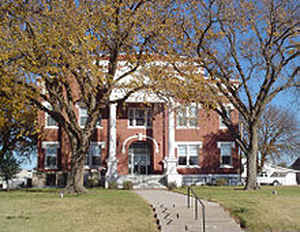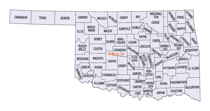Oklahoma Counties
There are seventy-seven counties in Oklahoma. Oklahoma originally had seven counties when it was first organized as the Oklahoma Territory. These counties were designated numerically, first through seventh. New counties added after this were designated by letters of the alphabet. The first seven counties were later renamed. The Oklahoma Constitutional Convention named all of the counties that were formed when Oklahoma entered statehood in 1907. Only two counties have been formed since thenEllis County, Oklahoma
Ellis County Education, Geography, and History

Ellis County is a county located on the western border of the state of Oklahoma. Based on the 2010 census, the population was 4,151, making
it the fifth-least populous county in Oklahoma. Its county seat is Arnett.
The county was named for Albert H. Ellis, vice president of the 1906 Constitutional Convention.
Etymology - Origin of Ellis County Name
Named for Abraham H. Ellis, member of the Constitutional Convention
Demographics:
County QuickFacts: CensusBureau Quick Facts
Ellis County History
This area was used by indigenous tribes that included the Comanche, Kiowa, Apache, Cheyenne, and Arapaho. In 1820, an
expedition led by Stephen Long passed through the area while exploring the Canadian River all the way to Fort Smith, Arkansas. Conflicts broke
out between the native Americans and the white settlers that were rapidly moving into Texas. In May 1858, the governor of Texas sent a force
of Texas Rangers, militia and allied Indians (notably the Tonkawas), led by Captain John S. "Rip" Ford into Indian Territory. Ford's command
fought a battle known as either the Battle of Little Robe Creek or the Battle of Antelope Hills inside the present Ellis County. The battle
was notable because it resulted in killing the Comanche chief, Iron Jacket, father of Peta Nocona and grandfather of Quanah Parker.
After the Civil War, roads and railroads turned the Ellis County area into a transportation corridor. A military road connected Fort Supply
with Fort Elliott. During the 1880s, the Western Trail, a cattle trail between Texas and Kansas, intersected the military road near the
present town of Fargo. The Southern Kansas Railway, later owned by the Atchison, Topeka and Santa Fe Railway, built a line in 1886-7 from
Kiowa, Kansas that resulted in starting three Ellis County towns: Fargo, Gage, and Shattuck.
When Oklahoma Territory was created, the present Ellis County became part of Day County. After statehood, several county boundaries changed
and resulted in the elimination of Day County. The northern part became Roger Mills County, while the southwestern part of Woodward County was
added to the remainder of Day County to become Ellis County. An election for location of the county seat in June 1908, resulted in a runoff
between the towns of Shattuck and Arnett. The latter won the runoff election and remains the county seat.
Oklahoma History Center
Named for Albert H. Ellis, a vice president of the 1906 Constitutional Convention, Ellis County lies in the state's
westernmost tier of counties, along 100th Meridian, the Texas state line. The southern border is the meandering Canadian
River. To the north lies Harper County and to the east, Woodward and Dewey counties. Ellis County encompasses a total
land and water area of 1,231.8 square miles, most lying within the Great Plains physiographic region. Originally
characterized by level, treeless, grassy prairies, much is now devoted to agriculture and grazing. Water features
include generally southward-flowing tributaries of the Canadian River and northward-flowing tributaries of the North
Canadian. The major stream is Wolf Creek, emptying into the North Canadian in Woodward County. Little Robe, Commission,
and Hackberry creeks empty into the main Canadian. In the southwestern corner of the county is the 4,800-acre Ellis
County Wildlife Management Area, with Lake Lloyd Vincent, and to the south, along the Canadian River, is the 17,000-acre
Packsaddle Wildlife Management Area. Both encourage grasslands-bottomlands flora and fauna....ELLIS
COUNTY
Geography: Land and Water
As reported by the Census Bureau, the county has a total area of 1,232 square miles (3,190 km2), of which 1,232 square miles
(3,190 km2) is land and 0.4 square miles (1.0 km2) (0.03%) is water.
The county is mostly within the Great Plains physiographic region.
The major stream is Wolf Creek, a tributary of the North Canadian River. Other waterways are Little Robe, Commission and Hackberry Creeks,
tributaries of the Canadian River, which forms the southern boundary of the county. The Ellis County Wildlife Management Area, with Lake Lloyd
Vincent, are in the southwestern corner of the county. Packsaddle Wildlife Management Area is in the south central part of the county, along
the Canadian River
Neighboring Counties
Bordering counties are as follows:
- Harper County (north)
- Woodward County (east)
- Dewey County (southeast)
- Roger Mills County (south)
- Hemphill County, Texas (southwest)
- Lipscomb County, Texas (west)
- Beaver County (northwest)
Education
Gage Public Schools are located in Ellis County.







